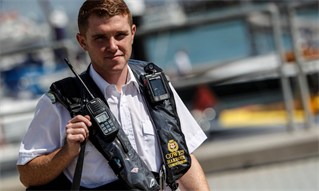
The cause of many leisure vessel incidents in Cowes Harbour can be traced back to just a couple of key factors, lack of proper preparation and planning.
Last year, Cowes Harbour Commission (CHC) Patrol Officers were called to over 70 incidents that could have been avoided through proper preparation and passage planning prior to a trip out on the water. The incidents included:
- Running out of fuel;
- Engine failure;
- Taking on water and bilge pump not working;
- Running aground;
- Fouled prop due to cutting through moorings;
- Being lost or not knowing a berth’s location.

Taking on water and bilge pump not working
By planning your passage you will also discover where there may be speed and wash restrictions; it’s like knowing where all the speed cameras are and slowing down so that you don’t get a ticket.
It may be second nature to experienced sailors, but for those who are proud owners of a new boat and heading out for the first time, or those that haven’t been aboard since last summer, here are a few handy tips to make sure you enjoy a safe and hopefully incident free day on the water:
BEFORE YOU LET GO
 Boat checks and planning should include, but are not limited to:
Boat checks and planning should include, but are not limited to:- Plan where you are going, how you will get there safely and by the correct routes.
- Know your draft and the likely depths you may encounter on the route, or if you wander off track.
- Check the tides for your planned route.
- Check that all your charts / navigation aids (echo sounder, plotter, GPS etc.) are working, up-to-date and that you know how to use them.
- Check your communications equipment is working correctly and have relevant contact numbers to hand.
- Take someone with you who also knows how to use the equipment / drive the boat.
- If you plan to be out alone, ensure you tell someone when and where you are going and what time you will arrive / return.
- Check that you have enough fuel to get there and back, allowing extra for a change of plans or emergencies.
- Check the oil / water in your engine and ensure it is properly maintained.
- Check that your bilge pump works.
- Check that your steering works.
- Check that the vessel is not taking on water.
- Check that everything else you may need is present and in good working order (sails, mast, rigging, winches, fenders, boat hook, kill cord etc.)
- Make sure you have suitable lifesaving equipment for your trip (lifejacket, life buoy, method of making a distress signal).
- Ensure you have enough supplies for your trip (food, water, first aid equipment, etc.)
- Check the weather forecast and any applicable vessel traffic information for your route.
UNDERWAY
Checks and monitoring should include but are not limited to:
- Check / plot your position at regular intervals to make sure you are on the planned route and not heading into danger.
- Keep a good lookout by sight and by hearing and by all available means.
- Monitor weather and vessel traffic reports for your area / route.
- Monitor your fuel levels.
- Check your bilges.
- If out on your own, report back to your shore contact at regular intervals.
- If your plans change whilst you are out, take some time to plan the new route and assess all potential risks.

Monitor weather and vessel traffic reports for your area / route
MAIB REPORTS
A recent MAIB report highlighted that poor planning, or the complete lack of it, caused a large racing yacht to ground and be lost. Thankfully, the crew were rescued. The main points were:
- The yacht was not safely manned or operated as the skipper was the only qualified, professional seafarer on board, and there was no dedicated navigator with responsibility for passage planning and execution.
- There was not an effective plan for the yacht’s coastal passage and, when unexpectedly close inshore, the skipper became distracted from navigation by the requirement to supervise the crew on deck.
The loss of this yacht could have been easily avoided through proper preparation and planning; a professional mate to oversee safe navigation and to stand-in for the skipper should they become ill or incapacitated, an effective passage plan accounting for possible risks, a crew member assigned to plot and confirm a position at regular intervals to see if they had been heading into danger, and an alarm set on the echo sounder. These are all simple things that could have averted the grounding and subsequent loss of the vessel. The MAIB investigation report into the incident makes interesting reading including what happened, safety lessons learned and recommendations.
 Additionally, the MAIB has a good YouTube channel with a wide variety of informative videos of marine incidents.
Additionally, the MAIB has a good YouTube channel with a wide variety of informative videos of marine incidents.
For more detailed information on lessons learned, go to the MAIB’s reports, which can usefully be viewed according to vessel and report type.
The MAIB also have an email alert subscription facility, where you can select the type of incident report alerts relevant to you, whether that is for a merchant vessel, fishing vessel, sail or power leisure craft.
Please remember, for those who are unfortunate enough to be involved in or witness to an incident in Cowes Harbour and the River Medina, you are required to report it to CHC so that we may pass on lessons learned to others and hopefully avoid a recurrence.


 Boat checks and planning should include, but are not limited to:
Boat checks and planning should include, but are not limited to:
 Additionally, the
Additionally, the 

